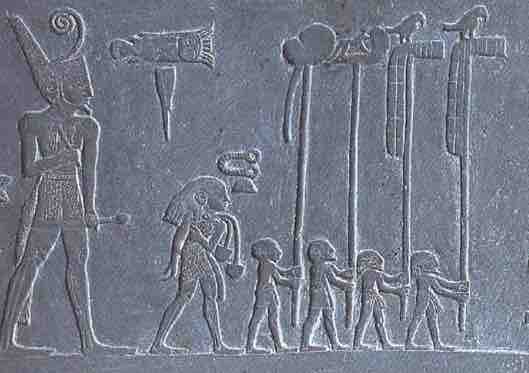Proportion is a measurement of the size and quantity of elements within a composition. Hierarchical proportion is a technique used in art, mostly in sculpture and painting, in which the artist uses unnatural proportion or scale to depict the relative importance of the figures in the artwork. In ancient Egyptian art, for example, gods and important political figures appear much larger than common people. Beginning with the Renaissance, artists recognized the connection between proportion and perspective, and the illusion of three-dimensional space. Images of the human body in exaggerated proportion were used to depict the reality an artist interpreted.

Depiction of Narmer from the Narmer Palette
Narmer, a Predynastic ruler, accompanied by men carrying the standards of various local gods. This piece demonstrates the ancient Egyptians' use of proportion, with Narmer appearing larger than the other figures depicted.
Mathematically, proportion is the relation between elements and a whole. In architecture, the whole is not just a building but the set and setting of the site. The things that make a building and its site "well shaped" include everything from the orientation of the site and the buildings on it, to the features of the grounds on which it is situated. Light, shade, wind, elevation, and choice of materials all relate to a standard of architectural proportion.
Architecture has often used proportional systems to generate or constrain the forms considered suitable for inclusion in a building. In almost every building tradition, there is a system of mathematical relations which governs the relationships between aspects of the design. These systems of proportion are often quite simple: whole number ratios or incommensurable ratios (such as the golden ratio) were determined using geometrical methods. Generally, the goal of a proportional system is to produce a sense of coherence and harmony among the elements of a building.
Among the various ancient artistic traditions, the harmonic proportions, human proportions, cosmic orientations, various aspects of sacred geometry, and small whole-number ratios were all applied as part of the practice of architectural design. For instance, the Greek classical architectural orders are all proportioned rather than dimensioned or measured modules, because the earliest modules were not based on body parts and their spans (fingers, palms, hands, and feet), but rather on column diameters and the widths of arcades and fenestrations.
Temple of Portanus
The Greek Temple of Portanus is an example of classical Greek architecture with its tetrastyle portico of four Ionic columns.
Typically, one set of column diameter modules used for casework and architectural moldings by the Egyptians and Romans is based on the proportions of the palm and the finger, while another less delicate module—used for door and window trim, tile work, and roofing in Mesopotamia and Greece—was based on the proportions of the hand and the thumb.
Dating back to the Pythagoreans, there was an idea that proportions should be related to standards, and that the more general and formulaic the standards, the better. This concept—that there should be beauty and elegance evidenced by a skillful composition of well understood elements—underlies mathematics, art, and architecture. The classical standards are a series of paired opposites designed to expand the dimensional constraints of harmony and proportion.